What an adventurous week we had! From too cold to be outside, to crazy winds, to over 40 degrees, then rainy and gray, and back to super cold. We enjoyed all the shades of weather that we experienced.








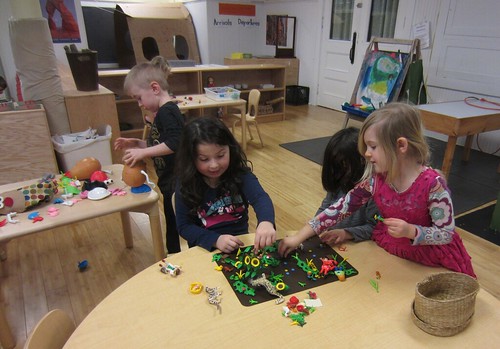


 For Monday art the children were introduced to block printing, as used by Japanese artist Hokusai. We examined a print of his work The Great Wave off Kanagawa. We learned how he would carve different sections then print them in layers to complete the entire picture. We looked through photos of his prints and located Mount Fuji in each, which is featured in a collection of his works. We then cut out sticky back foam and stuck them to woodblocks, creating our own “carvings,” which we used to print. Throughout the week all of the children enjoyed making their own stamps.
For Monday art the children were introduced to block printing, as used by Japanese artist Hokusai. We examined a print of his work The Great Wave off Kanagawa. We learned how he would carve different sections then print them in layers to complete the entire picture. We looked through photos of his prints and located Mount Fuji in each, which is featured in a collection of his works. We then cut out sticky back foam and stuck them to woodblocks, creating our own “carvings,” which we used to print. Throughout the week all of the children enjoyed making their own stamps.


 Monday students enjoyed some time at the library with Tammy while younger children visited the classroom for a playdate. They had fun with duplos, puppets, stories, and trains.
Monday students enjoyed some time at the library with Tammy while younger children visited the classroom for a playdate. They had fun with duplos, puppets, stories, and trains.
 We had a special visitor in the classroom on Tuesday. Susan Vigne, who will be joining us as the new classroom assistant, spent time getting to know the children, chatting and engaging with them as they worked throughout the morning. We are excited to have her join us!
We had a special visitor in the classroom on Tuesday. Susan Vigne, who will be joining us as the new classroom assistant, spent time getting to know the children, chatting and engaging with them as they worked throughout the morning. We are excited to have her join us!
The sensory table has been filled with rice. Most of the world’s rice is grown in Asia, and is a food staple in many Asian countries.


 The airplane was all set up and was very busy travelling the world. Travelers checked in with their baggage, boarded the plane, were greeted by the pilot and copilot, and cared for by the flight crew.
The airplane was all set up and was very busy travelling the world. Travelers checked in with their baggage, boarded the plane, were greeted by the pilot and copilot, and cared for by the flight crew.


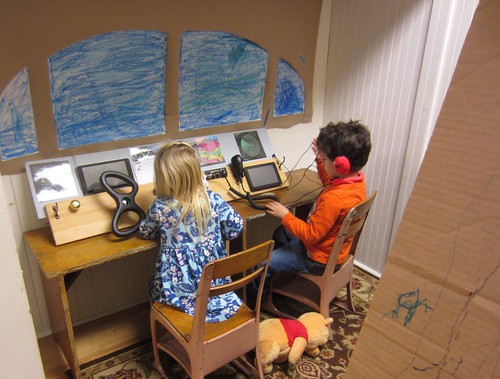





 We continued our study of Asia, with a continued focus on Japan. We read the story Suki’s Kimono about a little girl who wore her traditional Japanese Kimono and geta (wooden shoes) to school and shared them with her class. Although some of the students laughed at her, she stayed true to herself. The children discussed how they would stand up for themselves and others if in a similar situation. We read a bit about Tango no Sekku (children’s day) and learned that koinobori (carp streamers), are flown to represent courage and strength.
We continued our study of Asia, with a continued focus on Japan. We read the story Suki’s Kimono about a little girl who wore her traditional Japanese Kimono and geta (wooden shoes) to school and shared them with her class. Although some of the students laughed at her, she stayed true to herself. The children discussed how they would stand up for themselves and others if in a similar situation. We read a bit about Tango no Sekku (children’s day) and learned that koinobori (carp streamers), are flown to represent courage and strength.







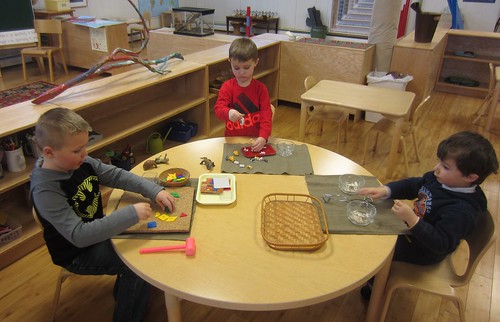











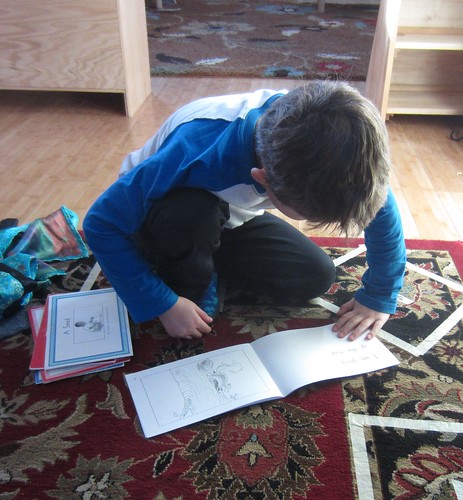



 Spanish with Zeanny resumed this week. She started off Session II by introducing casa (house), techo (roof), pequena (small), medio (medium), grande (large), tubo de lampara (chimney), rectangulo (rectangle) and triangulo (triangle). We listened to the story Oso en Casa (Bear at Home) and learned about all the different rooms in a house. Zeanny gave each child 6 Popsicle sticks to construct un casa, which will be used throughout this session.
Spanish with Zeanny resumed this week. She started off Session II by introducing casa (house), techo (roof), pequena (small), medio (medium), grande (large), tubo de lampara (chimney), rectangulo (rectangle) and triangulo (triangle). We listened to the story Oso en Casa (Bear at Home) and learned about all the different rooms in a house. Zeanny gave each child 6 Popsicle sticks to construct un casa, which will be used throughout this session.
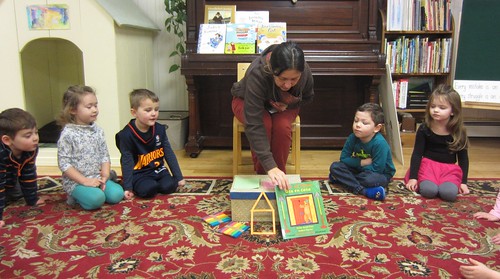

 On Thursday we introduced Martin Luther King Jr./Civil Rights Day. We took turns sharing what a holiday is, then moved on to a discussion about similarities and differences between people. Last week we talked about the varied shades of skin colors, eye colors, hair colors, and physical features of people on the earth. We continued to share how we are the same and how we are different, but pointed out that we are all people who are equal and should be treated as such. We introduced the laws of segregation that used to exist in parts of the United States, separating restaurants, water fountains, schools and where people could sit on buses based on the color of their skin. The children had many suggestions about what they would or could have done and we learned about Martin Luther King Jr. and what he did do to change these unfair laws. We read Martin’s Big Words: The Life of Dr. Martin Luther King, Jr. and learned how he used love and peaceful protests to combat hatred and anger.
On Thursday we introduced Martin Luther King Jr./Civil Rights Day. We took turns sharing what a holiday is, then moved on to a discussion about similarities and differences between people. Last week we talked about the varied shades of skin colors, eye colors, hair colors, and physical features of people on the earth. We continued to share how we are the same and how we are different, but pointed out that we are all people who are equal and should be treated as such. We introduced the laws of segregation that used to exist in parts of the United States, separating restaurants, water fountains, schools and where people could sit on buses based on the color of their skin. The children had many suggestions about what they would or could have done and we learned about Martin Luther King Jr. and what he did do to change these unfair laws. We read Martin’s Big Words: The Life of Dr. Martin Luther King, Jr. and learned how he used love and peaceful protests to combat hatred and anger.
 For Friday Science we talked and read about plants, their parts, and how they grow and change. We gently removed a spider plant from its’ pot and looked at the roots. We were surprised by how long the roots were. We discussed what the jobs are of the various parts. We learned how the roots soak up water and nutrients from the soil and how they stabilize the plant in the ground so that it remains secure where it is. We learned that the leaves use the water and sunlight to make food, how the stem carries the water and nutrients up to the leaves and flower, and how the flower, which may turn into fruit, houses the seeds, which are dispersed and turn into new plants. The children then started the germination process by placing paper towels in clear cups, watering them, and placing the beans between the wet paper towels and the cup. We will watch them until they begin to sprout, then plant them in dirt and see how they grow.
For Friday Science we talked and read about plants, their parts, and how they grow and change. We gently removed a spider plant from its’ pot and looked at the roots. We were surprised by how long the roots were. We discussed what the jobs are of the various parts. We learned how the roots soak up water and nutrients from the soil and how they stabilize the plant in the ground so that it remains secure where it is. We learned that the leaves use the water and sunlight to make food, how the stem carries the water and nutrients up to the leaves and flower, and how the flower, which may turn into fruit, houses the seeds, which are dispersed and turn into new plants. The children then started the germination process by placing paper towels in clear cups, watering them, and placing the beans between the wet paper towels and the cup. We will watch them until they begin to sprout, then plant them in dirt and see how they grow.


